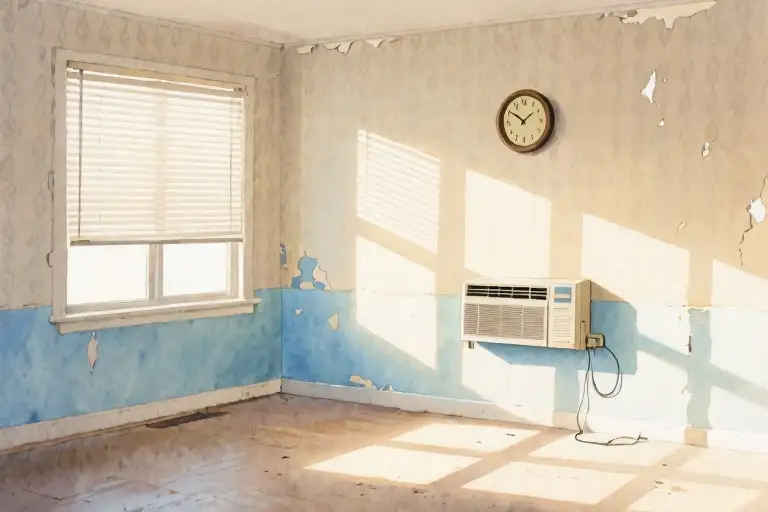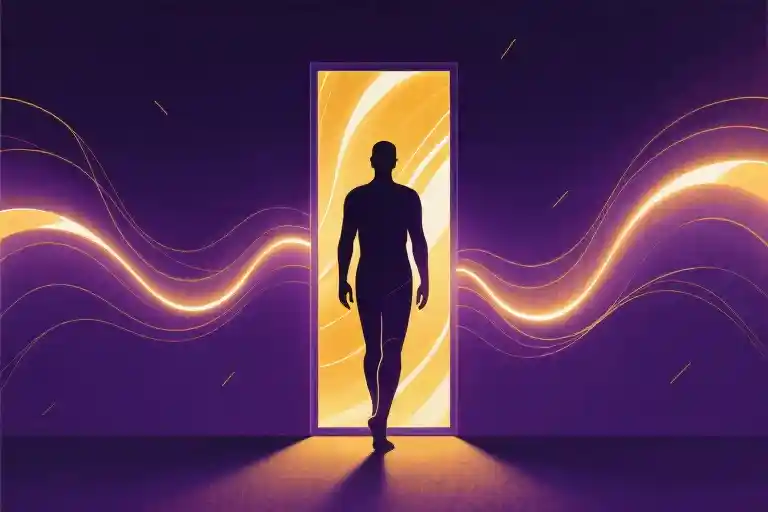The air conditioner died on a Tuesday afternoon. One moment it was humming its familiar white noise lullaby, the next — nothing. Just dead silence and the creeping realization that my apartment had become a greenhouse.
At first, I only noticed the heat. It pressed against my skin like a living thing, making the walls radiate warmth when I touched them searching for relief. My laptop keyboard grew uncomfortably warm beneath my fingers. But gradually, something else emerged from this thermal discomfort — an awareness of sound, or rather, the complete absence of it.
Working from home for three years had trained me to exist in constant auditory company. Podcasts narrated my lunch breaks, playlists scored my writing sessions, and the rhythmic churn of the washing machine marked the passage of time. These sounds created the illusion of activity, of life happening around me. Without them, the silence wasn’t peaceful — it was revealing.
My ears became strangely sensitive in that quiet. The ticking of the vintage wall clock I’d stopped noticing years ago now marked each second with military precision. The creak of my chair when I shifted weight sounded like tree branches breaking. Even my own chewing during meals became distractingly loud, each crunch echoing in the hollow space where background noise used to live.
This sensory shift made me realize how much we use noise as psychological insulation. That comforting podcast? Just another layer between me and my own thoughts. The ever-present fan noise? A buffer against the vulnerability of true quiet. We’ve created entire industries around manufacturing soundscapes to avoid confronting the contents of our own minds — playlists for focus, apps for sleep sounds, podcasts for loneliness.
Perhaps most unsettling was recognizing how this noise dependence bled into my work-life balance. The same sounds that helped me concentrate also prevented true disconnection. My apartment had become an endless workday punctuated by domestic sounds pretending to be personal time. When the silence came, it didn’t just reveal sounds — it revealed boundaries I’d allowed to dissolve.
In those quiet days before the repairman came, I began experimenting with short periods of intentional silence. Just five minutes at first, then ten. Not meditation — simply existing without auditory input. The clarity that emerged surprised me. Solutions to work problems appeared unbidden. Forgotten creative ideas resurfaced. Most importantly, I regained awareness of when I was truly tired, versus when I was just noise-exhausted.
We think of silence as absence, but that week taught me it’s actually a presence — one we’ve been trained to fear. The modern world sells us endless ways to avoid it, convincing us we need constant stimulation to function. But sometimes, all we really need is for the air conditioner to break.
When the Air Conditioner Stopped Breathing
The first thing I noticed was the heat. It clung to the walls of my apartment like a fever, radiating from surfaces that usually felt neutral to the touch. I pressed my palm against the bedroom wall — warm as a laptop left running too long. The air felt thick, resistant to movement, as if the atmosphere itself had given up on circulation.
Then came the silence. Not the peaceful kind you seek during meditation, but an abrupt vacuum where familiar white noise should have been. My ears strained against the absence, searching for the usual background hum that had become as constant as my own heartbeat. The silence felt physical, pressing against my eardrums with unexpected weight.
I checked the thermostat three times before accepting the reality: my faithful air conditioner, the unseen companion of my work-from-home existence, had stopped breathing. My immediate reaction surprised me — not just discomfort at the rising temperature, but a peculiar anxiety about the missing soundscape. I found myself repeatedly glancing at the silent vents, as if expecting them to spontaneously restart through sheer willpower.
As the minutes stretched, I became aware of how often I’d taken that background noise for granted. The steady mechanical breath of climate control had been the foundation of my daily soundtrack, beneath podcasts, beneath music, beneath the clatter of dishes in the sink. Without it, the apartment didn’t just feel hotter — it felt exposed, vulnerable, as if someone had removed a protective layer I hadn’t known existed.
Small sounds began emerging from this new silence. The refrigerator’s occasional gurgle, usually masked, now announced itself with theatrical prominence. The creak of floorboards under my bare feet sounded alarmingly loud. Even the rustle of my cotton shirt against skin became noticeable in ways that felt almost intimate. I caught myself holding my breath at moments, as if afraid my own exhalations might disturb some delicate balance.
This wasn’t the first time technology had failed me, but it was the first time its absence revealed something about my relationship with noise. That constant low-frequency vibration had been more than temperature control — it had been psychological padding, a buffer between me and complete awareness of my surroundings. Without it, I stood suddenly naked in sensory space, forced to notice details I’d trained myself to ignore.
The irony wasn’t lost on me. As someone who writes about mindfulness and mental clarity, I’d somehow missed how thoroughly I’d outsourced my peace to mechanical white noise. The very device meant to regulate my physical comfort had quietly become an emotional crutch, disguising my discomfort with silence behind its reliable mechanical whisper.
The Unfamiliar Sounds of Silence
The absence of the air conditioner’s hum did more than raise the temperature—it lowered some invisible barrier between me and the world. In that new quiet, sounds I’d trained myself to ignore came forward like shy guests at a party. The ticking of the office wall clock, a relic from pre-digital days, marked time with startling precision. My own body became an orchestra of peculiar notes: the wet click of swallowing coffee, the cartilage crackle when rotating stiff shoulders after hours at the keyboard, even the rustle of eyelashes blinking against dry contacts.
Most unsettling was hearing my breath—not the automatic inhale-exhale I took for granted, but a loud, deliberate process that made me self-conscious. It sounded like someone else’s breathing, something primal and animal that didn’t belong in my carefully curated workspace. I caught myself holding my breath just to stop the noise, then laughing at the paradox—choosing silence over the most fundamental evidence of being alive.
This auditory awakening revealed my elaborate noise infrastructure. The white noise app left running long after focus sessions ended. The perpetual YouTube “coffee shop ambiance” streams that tricked my brain into productivity mode. Even the refrigerator’s intermittent hum served as auditory padding against the vulnerability of pure quiet. These weren’t just background sounds; they were carefully constructed buffers between me and uninterrupted self-awareness.
The deeper revelation came when noticing which sounds emerged first in the silence. The physical ones—joints, digestion, breath—spoke of a body I’d been neglecting during marathon work sessions. The clock’s ticking underscored time’s passage in an era of endless digital scroll. The absence of expected noises (no message alerts, no video call chimes) highlighted how much I’d come to associate artificial sounds with being “connected.”
Modern life teaches us to treat silence like an empty container waiting to be filled. We mistake the absence of noise for the absence of content. But in those air conditioner-free hours, I learned that silence isn’t blank—it’s richly textured. It’s the canvas where subtle but essential frequencies finally become audible, the auditory equivalent of letting your eyes adjust to darkness until you see the constellations.
Perhaps we don’t fear silence itself, but what we might hear in it—not just the creak of chairs or the gurgle of plumbing, but the thoughts and questions we’ve been drowning out with our carefully curated soundtracks. The real background noise we’re avoiding isn’t in our environment; it’s the internal hum of unresolved ideas, unattended emotions, and unasked questions about how we’re really spending our days.
In that unexpected quiet, I didn’t just hear my environment differently—I heard myself differently. The experience left me wondering: When did we collectively decide that a life well-lived should be scored like a movie? And what might we rediscover if we occasionally turned off the soundtrack?
The Paradox of Noise: Why We Fear Silence
The hum of the air conditioner had been my constant companion for years – until it wasn’t. That first day of silence felt like losing a security blanket I never knew I carried. As the hours passed without mechanical white noise, I noticed something unsettling: my fingers tapping faster on the keyboard, my breath becoming deliberately shallow, the compulsive need to check my phone every few minutes. This wasn’t just discomfort with heat; it was full-blown silence anxiety.
Modern life has conditioned us to treat background noise as emotional insulation. That podcast playing while you work? The coffee shop chatter you seek for “focus”? The endless scroll of social media audio clips? They’re not just entertainment – they’re psychological buffer zones protecting us from the vulnerable quiet where unprocessed thoughts live. Research shows 68% of remote workers use constant background noise specifically to avoid confronting distracting thoughts or emotions (Journal of Environmental Psychology, 2022). We’ve created what psychologists call ‘pseudo-concentration’ – the illusion of productivity through auditory distraction.
There’s an uncomfortable irony in how we use noise to manufacture focus. The same generation that buys noise-canceling headphones for deep work compulsively fills that artificial silence with curated soundscapes. We’ve convinced ourselves that lo-fi beats help us concentrate, when often they’re just socially acceptable alternatives to facing the mental static beneath. As clinical psychologist Dr. Sarah Chen notes: “What we label as ‘background noise preference’ is frequently avoidance behavior in disguise – we’re not choosing sound, we’re fleeing silence.”
This noise dependence becomes especially apparent in blurred work-from-home environments. Without the natural boundaries of office life, we use auditory cues to compartmentalize: workout playlists signal ‘me time’, white noise apps create ‘office mode’, bedtime podcasts manufacture ‘wind down’ time. But these are fragile constructs. When my AC failed, I realized how much I relied on its hum to delineate ‘work hours’ from ‘living hours’ in my apartment. The silence collapsed those artificial walls, leaving me uncomfortably aware of how much work had seeped into personal time.
Perhaps most revealing is what happens when the noise stops. That first day, I caught myself reflexively reaching for my phone to queue up a podcast within 17 seconds of sitting down to work (yes, I timed it). The compulsion wasn’t about content – it was about creating psychological distance from myself. The silence had become a mirror, and like many modern professionals, I’d rather adjust the lighting than examine the reflection.
This isn’t to demonize all background noise. Sound can legitimately boost creativity or mask distracting environments. But when we can’t tolerate a silent elevator ride or feel phantom phone vibrations in quiet moments, it’s worth asking: what are we really trying not to hear? The answer might be hiding in those uncomfortable pauses between tracks, in the mechanical sigh of a broken air conditioner, in the space where we finally meet ourselves – undistracted and unforgivingly present.
When Noise Blurs the Boundaries
The moment my air conditioner died, I didn’t just lose climate control—I lost the invisible barrier between work and life. In our work-from-home era, background noise has become the psychological equivalent of an office cubicle partition, creating the illusion of separation where none truly exists. That constant hum we take for granted? It’s not just masking street sounds or neighbors’ conversations—it’s masking our own inability to transition between roles.
The Great Work-Life Illusion
Like many remote workers, I’d developed elaborate rituals to simulate workplace structure: dressing in ‘real clothes,’ setting coffee breaks at precise intervals, even playing those artificial coffee shop soundtracks. Yet when the background noise disappeared, I saw these for what they were—elaborate performances. Without the auditory curtain of typing sounds and podcast chatter, I could no longer pretend my kitchen table was an office. The silence revealed how thin the veneer of professionalism really was when my commute involved walking past unfolded laundry.
Digital Noise: The New Productivity Theater
We’ve replaced office white noise with something more insidious—the constant ping of notifications, the dopamine hits of social media refreshes, the comforting glow of multiple browser tabs. These digital distractions create what psychologists call ‘attention residue,’ where our brains never fully disengage from work tasks. That ‘quick email check’ during dinner? It’s the modern equivalent of leaving the factory whistle blowing all night.
The Paradox of Productive Noise
Research shows 68% of knowledge workers now use some form of background noise to focus (keyword: working from home distractions). But here’s the uncomfortable truth: our noise dependence might be less about productivity and more about avoiding the vulnerability of undivided attention. When I couldn’t hide behind my usual playlist, I noticed how often I’d reach for my phone the moment a challenging task arose—not to research, but to escape. The silence forced me to sit with difficult thoughts instead of drowning them in algorithmic chatter.
Micro-Silences as Boundary Markers
Small experiments helped me reclaim control:
- The ‘commute simulation’—five minutes of absolute quiet before and after work hours
- Physical noise cues (closing laptop with audible click, switching phone to grayscale)
- Designating ‘sound zones’ (no devices in bedroom, podcasts only in living room)
These practices didn’t eliminate noise, but made me conscious of how I use it. The real breakthrough came when I stopped judging my noise dependence and started observing it—noticing which tasks made me crave distraction, which emotions sent me scrolling. Turns out, the boundary we’re trying to enforce isn’t between work and life, but between ourselves and the discomfort of being fully present.
What sounds do you use as psychological dividers? And what might you hear if they suddenly stopped?
Redefining Silence
The absence of noise revealed an unexpected truth: what we call silence isn’t empty space between sounds, but rather a different quality of presence. When the mechanical hum of daily life disappeared, I discovered that true quiet doesn’t eliminate noise – it simply changes our relationship to it. The ticking clock wasn’t louder; my attention had become quieter.
This realization challenged everything I thought I knew about noise dependence. For years, I’d used background sounds as psychological scaffolding – white noise to concentrate, podcasts to avoid loneliness, music to regulate mood. But during those air conditioner-free days, something shifted. Without the constant auditory stimulation, my mind began doing something remarkable: it started settling rather than scrambling.
The Paradox of Productive Silence
Creative work transformed in unexpected ways. Where I normally required carefully curated playlists to write, now sentences formed with unusual clarity. The ideas weren’t better or worse – they simply arrived differently, like guests who no longer needed to shout over party music. Research suggests this isn’t just personal experience; studies on silence and mental health indicate even brief quiet periods can enhance cognitive flexibility and problem-solving.
Yet the most profound change wasn’t professional but perceptual. In that unmediated quiet, I noticed how much mental energy I’d been spending managing noise – adjusting volumes, skipping tracks, filtering irrelevant chatter. The constant auditory input had been like keeping all my apps running simultaneously. Silence, it turned out, was the ultimate system optimization.
Beyond Binary: Noise as Texture
This experience dismantled the false dichotomy between noise and silence. True quiet isn’t about eliminating sound, but about developing a different way of listening. The refrigerator’s occasional hum became comforting rather than irritating; distant traffic created rhythm rather than distraction. Without the masking effect of constant background noise, ordinary sounds gained texture and meaning.
Perhaps this explains why sudden quiet at home feels so unsettling initially. We’re not accustomed to hearing life’s natural acoustics – the symphony of creaking floors, rustling leaves, and our own breathing. These sounds have always been there, patiently waiting beneath our playlists and podcasts. When we finally listen, we’re not encountering emptiness, but rediscovering a fundamental layer of human experience.
The Gift of Unmediated Moments
In the weeks following the air conditioner’s repair, I began experimenting with intentional quiet. Not meditation (though that’s valuable), but simple pockets of technological abstinence – turning off devices during morning coffee, taking silent walks, cooking without auditory accompaniment. These weren’t grand gestures, but they created space for something increasingly rare: unmediated experience.
The modern world teaches us to fear such moments, equating quiet with boredom or loneliness. But what if we’ve misunderstood? Silence isn’t deprivation; it’s the return of something we forgot we’d lost. Like turning off a blinding light to see the stars, sometimes we need to switch off the noise to remember who we are when no one – not even a podcast host – is talking.
You might try it yourself. Start small: five minutes without headphones while commuting. Notice what arises when you stop outsourcing your attention. The experience won’t always be comfortable, but comfort isn’t the point. As I learned when my air conditioner failed, sometimes we need to sit with the heat before we appreciate the breeze.
When the Noise Returns
The mechanic arrived at noon, his tools clanking in a discordant symphony that already felt too loud. Within minutes, the air conditioner shuddered back to life with its familiar industrial purr. That first gust of cold air should have been relief, but something tightened in my chest as the white noise curtain descended again.
I stood very still, listening to the machinery reclaim its territory. The refrigerator resumed its intermittent buzzing. Traffic noise from the half-open window reassembled into its predictable rhythm. My podcast queue automatically played the next episode. The apartment exhaled, and just like that, every surface became polished smooth with sound.
This is comfort, I told myself while adjusting the thermostat. This is how things should be. Yet my fingers hesitated over the volume controls. That unplanned intermission of silence had left invisible cracks in my daily soundtrack. Now when I chewed my lunch, I noticed how the crunching synchronized with the clock’s second hand. When I stretched my arms, the shoulder joints popped in time with the refrigerator’s compressor cycle.
We think we’re choosing background noise, but more often it’s choosing us. That week without air conditioning taught me how easily we mistake the absence of chaos for emptiness. Modern life provides endless ways to outsource our stillness – productivity playlists, 24/7 news cycles, the dopamine drip of social media. We’ve built entire economies around helping people avoid their own company.
Maybe that’s why the return of noise felt heavier than its absence. That mechanical hum wasn’t just cooling the apartment; it was cooling my thoughts, preventing them from rising to a temperature where they might change state. The silence hadn’t been empty at all – it was the first time in years I’d heard my mind without distortion.
Three days later, I developed a new ritual. Every morning before turning on any devices, I sit by the window where the broken AC unit used to drip condensation. For exactly seven minutes (measured by that forgotten clock), I practice listening to whatever wants to be heard – the rustle of my own breath, the distant laughter of children walking to school, the way my pulse changes rhythm when a thought excites me.
Sometimes the air conditioner kicks on during these minutes. When it does, I no longer flinch. The noise and I have reached an understanding: it can fill the room, but it doesn’t have to fill me. That space belongs to something older, something no playlist can simulate – the quiet electricity of being present in my own life.
When was the last time you heard yourself think without interpretation? Not the curated version for social media or the professional persona for meetings, but the unedited voice that emerges when all the buffers shut down? It might be whispering something important under all that convenient noise.





